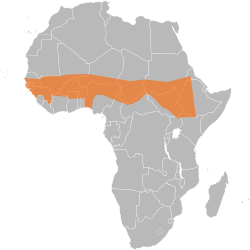African meningitis belt
The African meningitis belt is a region in sub-Saharan Africa where the rate of incidence of meningitis is very high. The primary cause of meningitis of the belt is Neisseria meningitidis.[1]

Regions
It consists of part of or all of (from West to East), the Gambia, Senegal, Guinea-Bissau, Guinea, Mali, Burkina Faso, Ghana, Niger, Nigeria, Cameroon, Chad, Central African Republic, Sudan, South Sudan, Uganda, Kenya, Ethiopia, Eritrea. The "belt" has an estimated 300 million people in its total area. This region is not only prone to meningitis,[2] but also very prone to epidemics such as malaria.
The most affected countries in the region are Burkina Faso, Chad, Ethiopia, and Niger. Burkina Faso, Ethiopia, and Niger were accountable for 65% of all cases in Africa. In major epidemics, the attack rate range is 100 to 800 people per 100,000. However, communities can have attack rates as high as 1000 per 100,000. During these epidemics, young children have the highest attack rates.[3] More than 90,000 cases reported in the belt in 2009, contrary to less than 800 cases of that in the United States[1] in 2011.
Meningitis vaccine
The Meningitis Vaccine Project was conceived in 2001 as an effort to stop the spread of meningitis in this region. As of June 2011, reports projected that the meningitis in this region would be under control with efficiency that local governments had desired.
References
- Murray, Patrick R.; Rosenthal, Ken S.; Pfaller, Michael A. Medical microbiology (8th ed.). Philadelphia, PA. ISBN 9780323299565. OCLC 914223501.
- "Archived copy". Archived from the original on 2008-05-19. Retrieved 2009-10-20.CS1 maint: archived copy as title (link)
- "Archived copy". Archived from the original on 2014-04-29. Retrieved 2014-04-28.CS1 maint: archived copy as title (link)